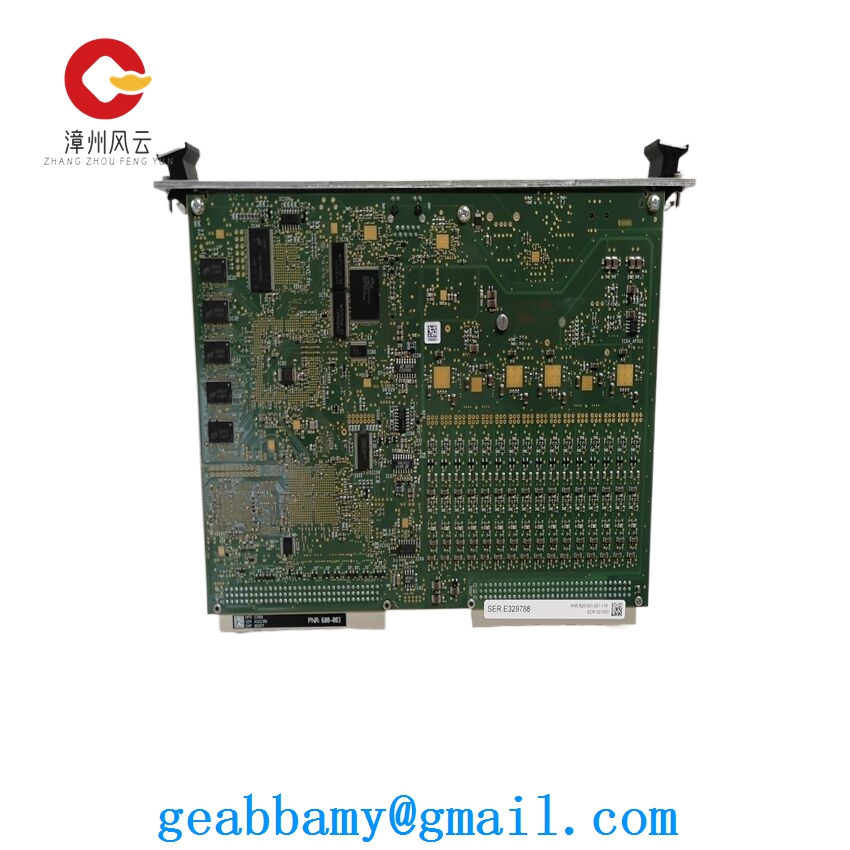Technical Parameters of ABB PFSK 130 Control Board (NEW)

1. General Overview
The ABB PFSK 130 Control Board is a cutting-edge component designed for advanced control and automation applications within industrial systems. It represents a significant advancement in control technology, offering enhanced performance, reliability, and flexibility to meet the demands of modern industrial processes.
2. Key Technical Specifications
2.1 Processor and Computing Power
- Processor Type: Equipped with a high – performance, multi – core processor capable of handling complex control algorithms and real – time data processing tasks with exceptional speed and efficiency. The processor architecture is optimized for industrial control applications, ensuring low – latency response and high – throughput operation.
- Clock Speed: Operates at a clock speed of [X] MHz, providing ample computational power to execute multiple control tasks simultaneously without any performance bottlenecks.
- Memory:
- RAM: Features [X] MB of high – speed RAM, which allows for the smooth execution of control programs, temporary storage of data during processing, and efficient multi – tasking.
- Flash Memory: Includes [X] MB of non – volatile flash memory for storing the control software, configuration parameters, and other essential data. This ensures that the control board retains its settings and programs even during power outages.
2.2 Input/Output (I/O) Capabilities
- Digital Inputs:
- Number of Channels: Provides [X] digital input channels, each capable of interfacing with a wide range of digital sensors and switches. The inputs are isolated to protect the control board from electrical noise and voltage spikes, enhancing system reliability.
- Input Voltage Range: Accepts digital input signals within a voltage range of [X] V to [X] V, making it compatible with various industrial signal standards.
- Digital Outputs:
- Number of Channels: Offers [X] digital output channels for controlling actuators, relays, and other digital devices. The outputs are designed to provide high – current drive capability, with a maximum load current of [X] A per channel (at [X] V).
- Output Type: Supports both transistor – transistor logic (TTL) and relay – type outputs, allowing for flexible integration with different types of loads.
- Analog Inputs:
- Number of Channels: Equipped with [X] analog input channels for connecting to analog sensors such as temperature transmitters, pressure sensors, and level sensors.
- Input Range: The analog inputs can be configured for different input ranges, including 0 – 10 V, 4 – 20 mA, etc., to accommodate a wide variety of analog signal sources.
- Resolution: Provides a high – resolution analog – to – digital conversion (ADC) with a resolution of [X] bits, ensuring accurate measurement of analog signals.
- Analog Outputs:
- Number of Channels: Features [X] analog output channels for controlling analog devices such as variable – speed drives and valve positioners.
- Output Range: The analog outputs can be set to output signals within ranges such as 0 – 10 V or 4 – 20 mA, with a high level of accuracy and stability.
2.3 Communication Interfaces
- Ethernet:
- Ports: Integrates [X] Ethernet ports, supporting 10/100/1000 Mbps data transfer rates. This enables high – speed communication with other devices in the industrial network, such as programmable logic controllers (PLCs), human – machine interfaces (HMIs), and supervisory control and data acquisition (SCADA) systems.
- Protocols: Supports standard Ethernet protocols including TCP/IP, UDP, and Modbus TCP, facilitating seamless integration into existing industrial networks.
- Serial Communication:
- Ports: Includes [X] serial communication ports (RS – 232/RS – 485), which are widely used in industrial automation for connecting to legacy devices and other serial – based equipment.
- Baud Rate: The serial ports support a wide range of baud rates, from [X] bps to [X] bps, ensuring compatibility with various serial devices.
- Fieldbus Interfaces:
- Optional: Offers optional fieldbus interfaces such as Profibus, Profinet, or DeviceNet (depending on the specific model or configuration). These fieldbus interfaces enable direct communication with field – level devices, reducing wiring complexity and improving system flexibility.
2.4 Power Supply
- Input Voltage Range: The control board can be powered from a wide input voltage range of [X] V AC to [X] V AC or [X] V DC to [X] V DC, making it suitable for use in different industrial power environments.
- Power Consumption: Has a low power consumption of [X] W (typical) under normal operating conditions, contributing to energy efficiency and reducing operating costs.
2.5 Environmental Specifications
- Operating Temperature: Can operate reliably in a temperature range of – [X] °C to + [X] °C, making it suitable for use in a variety of industrial environments, including harsh and extreme temperature conditions.
- Storage Temperature: Withstands storage temperatures ranging from – [X] °C to + [X] °C without any damage or performance degradation.
- Humidity: Designed to operate in relative humidity conditions of up to [X] % (non – condensing), ensuring reliable performance even in humid industrial settings.
- Vibration and Shock Resistance: Complies with industry – standard vibration and shock resistance specifications, capable of withstanding the mechanical stresses commonly encountered in industrial applications.
3. Software and Programming
- Programming Software: Compatible with ABB’s dedicated programming software, which provides a user – friendly interface for developing, configuring, and debugging control programs. The software supports ladder logic, structured text, function block diagram, and sequential function chart programming languages, offering flexibility to engineers and programmers.
- Firmware Upgradability: The firmware of the PFSK 130 Control Board can be easily upgraded over the network or via a local connection, allowing for the addition of new features, performance improvements, and compatibility with emerging industrial standards.
4. Safety and Certifications
- Safety Features: Incorporates multiple safety features such as over – voltage protection, over – current protection, and short – circuit protection to ensure the safety of the control board and the connected devices.
- Certifications: Meets various international industrial safety and electromagnetic compatibility (EMC) standards, including but not limited to [List of relevant standards, e.g., IEC 61131 – 2, CE, UL]. These certifications guarantee the quality, reliability, and compliance of the control board with global industrial regulations.
In summary, the ABB PFSK 130 Control Board (NEW) is a highly advanced and versatile control solution that combines powerful processing capabilities, extensive I/O options, flexible communication interfaces, and robust environmental performance. It is an ideal choice for a wide range of industrial control applications, offering users improved efficiency, productivity, and system reliability.


